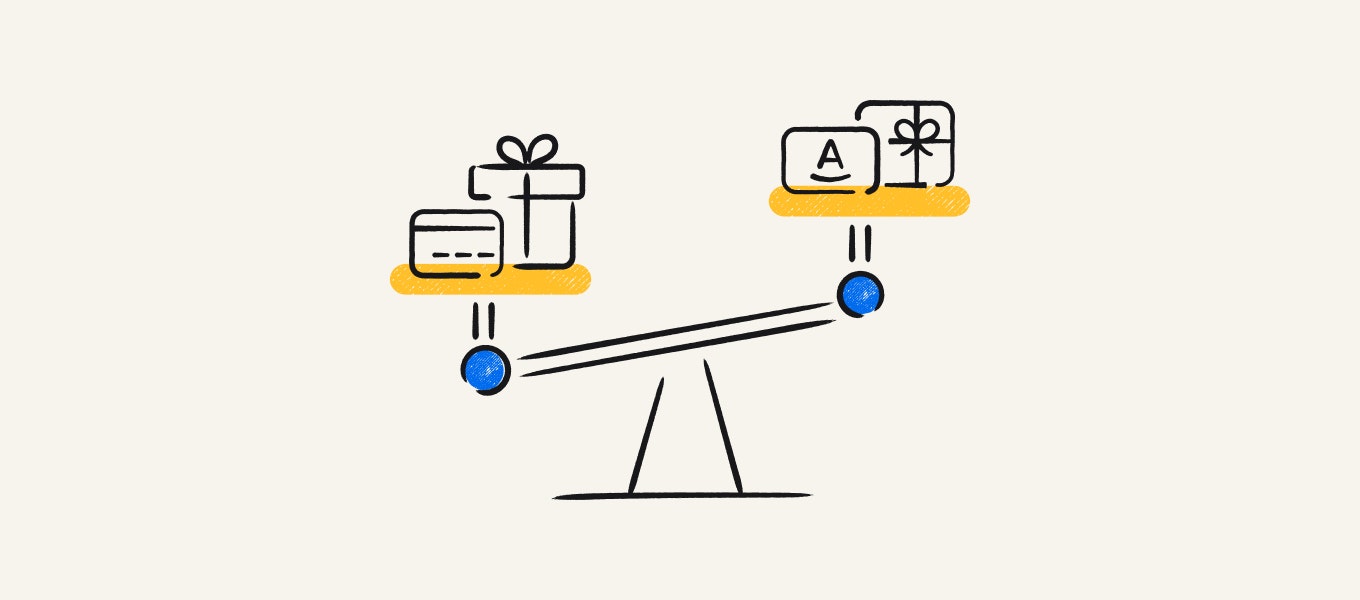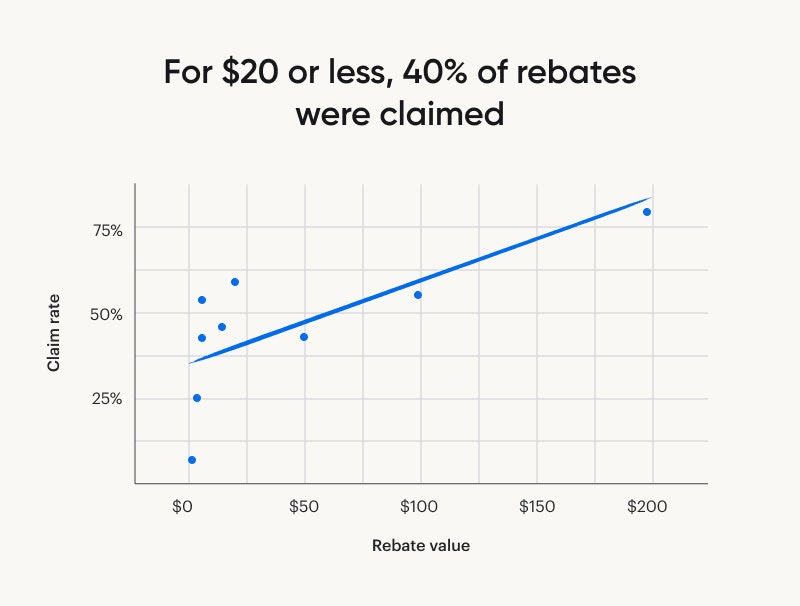Rebates vs discounts: Differences, examples, & more
By Ian Floyd, Kate Monica, and The Decision Lab●5 min. read●Oct 10, 2024

In the world of consumer promotions, both discounts and rebates are ubiquitous. But there are key differences between a rebate and a discount that make one a better tool than the other. In this article, we'll walk you through the math and mechanics of rebates vs discounts.
What is a consumer rebate?
A rebate is a conditional promotion, meaning that the consumer has to claim the savings. They don’t just automatically receive them. As a result of that additional effort, not all rebates will be redeemed. In other words, you’ll sell a fair chunk of the product at full price.
Examples of rebates
Rebate program examples are everywhere. They just don't always call themselves rebates.
Cashback with purchase — These are your bread-and-butter rebate programs. A consumer purchases a good or service, and they receive money or a gift card in return.
Sign-up incentives — These rebate programs are common in commoditized or highly regulated markets. For example, if you have to choose between to internet service providers, you might select the one that's offering a $100 Visa prepaid card for signing up.
Incentives for attending a meeting — Some businesses rely on consumers attending a meeting prior to the purchase. If you've ever bought a house, you know that the salesperson for curtains or a water softener wants an in-home consultation. To encourage participation, many companies offer an incentive. That's also when the sale is closed, and thus the consumer receives a rebate.
What are the benefits of giving consumers rebates?
Rebate marketing increases sales without forcing the seller to drop their price (in the form of a discount).
Rebates have proven to convince customers to buy more products.
And because rebates are conditional (meaning they have to claim it), not everyone does. This keeps margins high while boosting sales.
What is a discount?
A discount is a reduction in the purchase price of a good or service. Discounts are simple. You sell something. That thing has a standard price. But you sell that thing for a chunk less than that price. Consumers love them.
Examples of discounts
Product or service discounts are ubiquitous, and often tied to specific promotions or seasonal events.
Black Friday and Cyber Monday — this is the biggest consumer promotion event of the year, offering steep discounts on just about every product.
Manufacturer discounts — sometimes a manufacturer is sitting on too much inventory and needs to move the product, so they'll offer retailers discounts on the product.
What are the benefits of discounts?
Discounts immediately benefit the consumer at the time of purchase.
Discounts often increase sales volume.
However, discounts can put negative pressure on the original price of the good or service, causing an overall drop in price over time.
Differences between rebates and discounts at a glance
The key difference between rebates and discounts is when the consumer receives the money. Discounts are issued at the time of purchase. Rebates must be claimed post-purchase, or by following through on a pre-established task.
What's better, a rebate or a discount?
In most cases, rebates are a more efficient use of marketing budget than a discount of equal value.
Discounts are simpler to implement, and they drive higher sales.
Rebates can yield almost as many sales, but requires ⅓ of the budget on average, because not everyone claims rebates.
Unless you expect a 90% claim rate — and our experiments suggest claim rates are much lower — it’s generally more cost effective offer a rebate.
We teamed up with The Decision Lab (TDL), an applied research and innovation firm, to prove that rebates are superior. To do so, we explore the two most important considerations that separate rebates from discounts:
The value that consumers place on a rebate versus a discount
How likely someone is to actually claim a rebate at different dollar amounts
_________________________________________________________________________
🧠 We spent a lot of brainpower to prove this point. So you don’t have to.
If you can take our word for it (or don’t care for math), here’s some other content that might be relevant.
________________________________________________________________________
How (and why) rebates and discounts work
Rebates benefit from some idiosyncrasies in human psychology: people overestimate the likelihood that they’ll claim a rebate.
This tendency towards optimism means that consumers perceive rebate offers as more valuable than they are. And that’s the key for maximizing your promotions budget.
How consumers perceive product discounts and rebates
If presented with a rebate and a discount of equal value, people prefer discounts. We measured it. It’s true. But even with that preference, rebates are still better.
Learn why rebates are a great consumer promotion.
In our rebate vs discount experiment:
We sold a $950 washing machine.
We offered incentives between 10% and 40% of the sales price.
We served people two options, and asked them to tell us which is the better deal. Some were rebates. Others were discounts.
Based on consumers’ choices, we modeled the relative value of a discount and rebate.
Turns out, people see rebates as 9.9% less valuable than discounts.
So, on a $1,000 product, a 10% incentive is more valuable as a discount. It’s perceived as being worth $100 as a product discount. Or, $90 as a rebate. If you stop thinking here, then a discount is a no-brainer.
But a $100 discount has a 100% redemption rate. What redemption rate does a $100 rebate have?
How effective are rebates? Do they reduce revenue?
If you can believe it, there’s been no good published data about how often digital rebates are claimed. So we ran another experiment:
275 people were offered a chance to claim a rebate.
Each was randomly assigned an offer — from $0.50 to $200 — paid out through Tremendous.
Participants were prompted to provide their email address in exchange for the rebate offer.
Three business days later, they received an email with instructions on how to claim their rebate.

For a rebate of $20 or less, only 38% were claimed. (This is higher than the 30% benchmark established decades ago for mail-in rebates, but not by much.)
It’s a little less than 50% for rebates of $50.
The claim rate never reached 100% — only 4 of the 5 people offered $200 followed through on their extra payment.
To return to our example, around 60% of people claimed a $100 rebate.
For a deeper look at how we arrived at these conclusions, check out our research methodology.
When does a rebate beat a discount?
Short answer: pretty much always.
The long answer requires some math.
Let’s start with a few assumptions before we walk through the example:
You’re already expecting to sell 10,000 units
Your product costs $1000
You’ll be offering an incentive of $100, or 10% of the cost of the product
Your product has a promotional elasticity of 2. That means that for every 10% off of the price of your product, you can expect to increase your sales by 20%
| Parameter | Discount | Rebate |
|---|---|---|
| Assumed baseline sales | 10,000 | 10,000 |
| Product price | $1,000 | $1,000 |
| Offer value | $100 | $100 |
| Promotional elasticity | 2 | 2 |
| Perceived offer value | $100 | $90 |
| % increase in sales | 20% | 18% |
| Total sales | 12,000 | 11,800 |
That gives us enough to start exploring the differences between a rebate and a discount.
The 10% discount can be expected to increase sales by 20%, so you’ll sell 12,000 units
We know that the rebate is perceived as less valuable. It will feel like it’s worth $90, or 9% of the cost of the product.
This means that the rebate can be expected to increase sales by 18%, so you’ll sell 11,800 units.
| Parameter | Discount | Rebate |
|---|---|---|
| Claim rate | N/A | 60% |
| Claimed incentives | 12,000 | 7,080 |
| Incentive cost | $1,200,000 | $708,000 |
| Cost per additional sale | $600 | $393.33 |
With the discount, 12,000 sales means that you give out 12,000 incentives.
The cost of the campaign would be $1,200,000
That’s a cost per additional sale of $600
For rebates, our experiment suggests a claim rate of approximately 60%.
You would expect to actually pay out 7,080 rebates
The cost of the rebate campaign would be $708,000
That’s a cost per additional sale of $393.33
Why are rebates better than discounts?
They’re way better for profit margins.
You will generate about 10% fewer additional sales through a rebate program
However, in this example, spend 33% less to still get 90% of the sales
In our example above, the rebate program costs 33% less. Savings will vary depending on the expected claim rate, but in general, a rebate is more cost effective than a discount even at a claim rate of 90%.
The largest rebate in our experiment - $200 - only had a claim rate of 80%.
When in doubt, your best bet is to go with a rebate.
How to set up a DIY rebate program
If you’ve never offered a rebate before, it’s worth it to try.
You don’t need to enlist the help of an outside company to run your rebate program, either. It’s easier to set up a rebate program than you’d think. We put together a quick-start guide for using Tremendous to run a consumer rebate program.